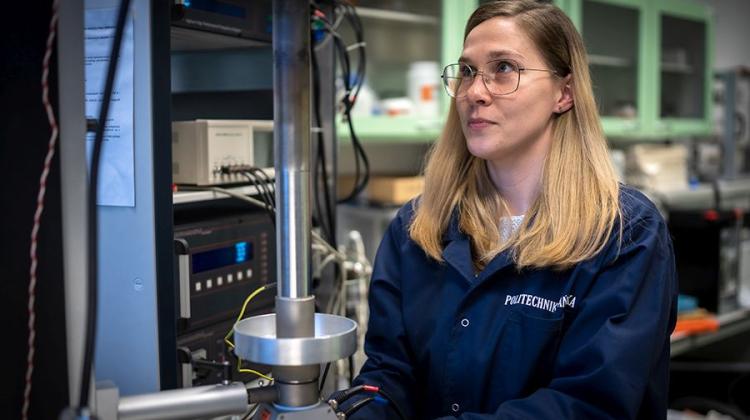Gdańsk researcher searches for synthetic alternatives for bone implants
 Dr. Natalia Wójcik. Credit: Dawid Linkowski/PG
Dr. Natalia Wójcik. Credit: Dawid Linkowski/PG
Dr. Natalia Wójcik from the Gdańsk University of Technology is looking for alternative materials for the production of composites used in bone implants. Her research can contribute to the development of more advanced implants that will regenerate bone defects without disrupting the biochemical balance of the body.
According to the Gdańsk University of Technology press office, the materials currently used in bone implants contain bioactive glass. It is commonly used silicate-based glass, which is also added to toothpastes. They give implants their properties that force the bone to regenerate exactly in the place where they are located. Silicon oxide accounts for 50% of the composition of this glass, the remainder being phosphorus, calcium and sodium oxide admixtures.
'The silicate-based glass used now dissolves very slowly. If we place this material where the defect is, it is intended to stimulate the bone to produce hydroxyapatite, the main building block of the bone, and thereby regenerate, gradually dissolving itself. Classic bioglass with a high silicon content, however, dissolves too slowly, from one year to even several years. The problem is that silicon is an element that occurs naturally in the human body only in trace amounts. We do not know the long-term consequences of this element remaining in the body in high concentration', says Dr. Natalia Wójcik from the Institute of Nanotechnology and Materials Engineering, Gdańsk University of Technology.
Replacing the main silicate matrix in bioglass production with a phosphate matrix considerably increases the solubility of the material, because such are the properties of phosphates. Moreover, phosphorus occurs in living organisms and is a natural building block of bones, so dissolving it will not be a burden, as in the case of silicon.
Dr. Natalia Wójcik is working on phosphate-based materials that will achieve optimal dissolution properties for a given bone defect. 'Simply speaking, the implant must dissolve slowly enough for the bone to regenerate and fast enough not to interfere with the last stage of regeneration', she says.
According to the Gdańsk University of Technology press office, in addition to phosphorus, the composition of the bioglass produced and tested by the researcher includes calcium and sodium, as well as niobium and nitrogen. Adding a small amount of nitrogen does not have negative effects on the body, however it affects the solubility. Niobium, on the other hand, improves the bioactive properties of the material and also affects the solubility.
In the next stage, Dr. Wójcik extended her in vitro research of the solubility of bioactive glass to magnesium and aluminium. So far, she has published four articles on this topic. She conducts her research in collaboration with research centres in Sweden, Finland and Saudi Arabia and with the support of Stefania Wolff, an engineer. The target result of her research is a composite that can be used to produce advanced implants that fill mini cavities in bones and accelerate bone regeneration or serve as coating for permanent, e.g. titanium implants. (PAP)
Author: Krzysztof Wójcik
kszy/ agt/ kap/
tr. RL
Przed dodaniem komentarza prosimy o zapoznanie z Regulaminem forum serwisu Nauka w Polsce.














